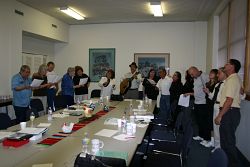Cursillistas are committed to forming a team, planning cursillos

SALT LAKE CITY - Cursillistas of all languages came together to commit themselves to bringing the cursillo movement to the Diocese of Salt Lake City in the Pastoral Center June 15.
"A cursillo is a movement which calls us to stay close to God and a cursillista is someone who has made a cursillo," said Maria-Cruz Gray, director of Hispanic Ministries for the diocese. "The cursillo movement was started in Spain in 1940 by Eduardo Bonin and was approved by Pope Pius XII, who addressed the world saying we need to help our brothers and sisters return to their Christian beliefs. A cursillo is a pilgrimage back to the Father and the purpose is to save souls and to build a Christian community."
"Cursillistas are the main core of leaders of the cursillo," said Jorge Barcelo, national coordinator of the Hispanic Cursillo Movement, who was the guest speaker at the June 15 event. "Bringing the cursillo movement to your diocese will take people to step forward to volunteer to train the team, or secretariat of cursillistas to put on the three-day cursillo. We need at least 20 to 25 leaders to encourage 20 to 25 candidates to come to the cursillo."
Life is never the same after attending a cursillo, said Jim Duff, a cursillista who is part of the team working to bring the cursillo movement back to the Diocese of Salt Lake City. "During a cursillo we want individuals to have three essential encounters: with self, with Christ and with others. You experience God's grace at a cursillo."
The cursillo is divided into three steps: the pre-cursillo, the cursillo, and the post cursillo. The pre-cursillo is a person searching for Christ, who prays to find an authentic witness. This potential candidate has to have a sponsor to share the cursillo, and a sponsor is a cursillista.
During the cursillo, the person encounters Christ through word, testimony, Scripture and doctrine, and is asked to have an open heart and mind so God can enter.
"The post-cursillo goes on forever," said Gray. "The candidate becomes a cursillista following Christ through authentic action and evangelization."
To be successful, the movement needs a team of committed people are willing to meet weekly to form a community, said Barcelo.
"When I was involved in planning a cursillo in the Spanish movement, we used to meet in our houses and we would cook together for each other," said Gray. "We grew together and became a cohesive group and that is why I think our cursillo was so successful."
Barcelo agreed. "That is what I mean by being committed."
In the Diocese of Salt Lake City, a group of people from Saint George Parish under the direction of Father Gustavo Vidal has sought permission from Bishop John C. Wester to attend a cursillo in Arizona if one isn't planned soon in Utah, said Duff. "Another alternative is to have a team from another diocese come to Salt Lake City to put on a cursillo."
The local team concluded they were committed to meet biweekly to first plan a cursillo for men in English, then for women in English, for men in Spanish and for women in Spanish. The Anglos and the Hispanic cursillistas will help each other with meals and other essentials during each cursillo.
© Copyright 2025 The Diocese of Salt Lake City. All rights reserved.

Stay Connected With Us